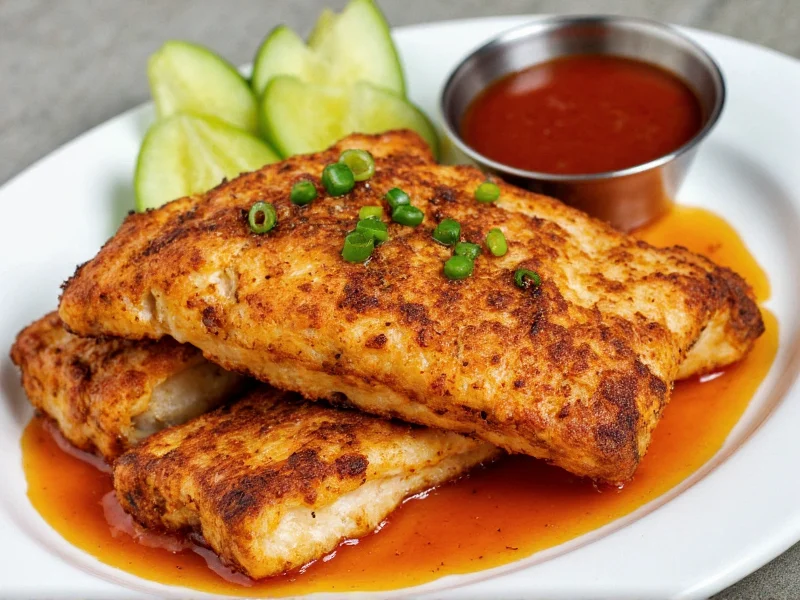Understanding whether blackened fish is spicy requires examining both the cooking technique and the spice blend used. The blackening method itself—searing fish in a very hot cast-iron skillet—creates a flavorful crust, but it's the spice mixture that determines the heat level. Traditional blackened fish recipes include cayenne pepper as a key ingredient, which provides noticeable heat, but many modern variations offer milder options.
What Exactly Is Blackened Fish?
Blackened fish refers to a cooking technique developed by Chef Paul Prudhomme in the 1980s that involves coating fish fillets with a spice blend and cooking them in a smoking-hot cast-iron skillet. The high heat creates a dark, flavorful crust—hence the term "blackened"—while keeping the interior moist and flaky.
Contrary to what some believe, the "blackened" part refers to the dark crust formed during cooking, not necessarily to spiciness. However, the traditional spice rub used in this technique does typically include heat-producing ingredients.
Breaking Down the Blackened Spice Blend
The spice mixture used for blackening fish determines its heat level. Here's what typically goes into a traditional blackened fish seasoning:
| Spice Ingredient | Heat Level (Scoville Units) | Contribution to Flavor Profile |
|---|---|---|
| Cayenne pepper | 30,000-50,000 | Primary source of heat in traditional blends |
| Paprika | 500-1,000 | Provides color and mild sweetness |
| Garlic powder | 0 | Earthy, savory notes |
| Onion powder | 0 | Additional savory depth |
| Dried thyme | 0 | Herbal complexity |
| Dried oregano | 0 | Mediterranean herbal notes |
| Black pepper | 100-500 | Sharp, pungent heat |
| White pepper | 10,000-20,000 | Distinctive sharp heat |
Factors That Determine Blackened Fish Spiciness
Several elements affect how spicy blackened fish turns out:
Recipe Variations
Traditional New Orleans-style blackened fish recipes contain significant heat from cayenne pepper, often ranging from 1-2 teaspoons per cup of spice blend. However, many contemporary recipes reduce or eliminate the cayenne to create milder versions that focus on the herbal and aromatic elements of the spice rub.
Chef's Technique
Professional chefs often adjust spice levels based on their clientele. In regions where palates prefer milder food, restaurants commonly serve blackened fish with reduced heat. Some establishments even offer spice-level choices, similar to how you might select heat levels for wings.
Home Cooking Adjustments
When preparing blackened fish at home, you have complete control over the spice level. Many home cooks seeking to understand is blackened fish always spicy discover they can create satisfying versions with minimal heat by:
- Reducing or eliminating cayenne pepper
- Increasing paprika for color without heat
- Adding more herbs like thyme and oregano
- Using smoked paprika for depth without spiciness
Blackened Fish vs. Other Cooking Methods: Spiciness Comparison
Understanding how blackened fish compares to other preparation methods helps answer how spicy is blackened fish in context:
- Blackened vs. Grilled: Grilled fish typically has no inherent spice unless a spicy marinade is used, while blackened fish almost always includes some spice elements in the rub.
- Blackened vs. Fried: Fried fish might have mild seasoning in the batter, but rarely reaches the heat level of traditional blackened preparations.
- Blackened vs. Cajun: While related, Cajun cooking encompasses a broader range of dishes—blackened is a specific technique within Cajun cuisine that often features more concentrated spice on the exterior.
Creating Mild Blackened Fish: Practical Tips
If you're wondering can you make blackened fish not spicy, the answer is absolutely yes. Here's how to achieve the signature blackened crust with minimal heat:
- Adjust the spice ratio: Use a 4:1 ratio of paprika to cayenne, or eliminate cayenne entirely for a mild version.
- Add sweetness: A small amount of brown sugar (1-2 teaspoons per cup of rub) balances any remaining heat.
- Increase herbs: Boost thyme, oregano, and marjoram to maintain complexity without heat.
- Use smoked paprika: This provides deep flavor and color without significant heat.
- Control cooking temperature: Properly managing the skillet temperature ensures the spice rub chars without burning, which can create bitter notes that mimic excessive heat.
Popular Blackened Fish Variations by Heat Level
Understanding blackened fish spice level options helps you select or create the perfect dish for your palate:
- Traditional New Orleans Style: Significant heat from generous cayenne (1-2 tsp per cup of rub), often rated 7-8 on a 10-point heat scale.
- Restaurant Mild Version: Reduced cayenne (¼-½ tsp per cup), balancing heat with prominent herbal notes, typically 3-4 on heat scale.
- Kid-Friendly Version: No cayenne, increased paprika and herbs, sometimes with a touch of sugar, registering 1-2 on heat scale.
- Extra Hot Version: Additional cayenne plus hot paprika or even a pinch of ghost pepper powder, reaching 9-10 on heat scale.
Does Blackened Mean Burnt?
A common misconception is that blackened fish is burnt. The dark crust is actually a carefully controlled Maillard reaction—the browning of proteins and sugars at high heat. When properly executed, blackened fish has a flavorful, slightly charred exterior with no bitter, burnt flavors. The spice rub contributes to this reaction, creating complex flavors beyond simple spiciness.
Final Thoughts on Blackened Fish Spiciness
The question is blackened fish spicy doesn't have a simple yes or no answer—it depends entirely on the specific recipe and preparation. Traditional preparations are moderately to highly spicy, but the technique easily accommodates customization. Whether you prefer fiery heat or subtle seasoning, blackened fish can be adapted to your taste preferences while maintaining its distinctive charred crust and rich flavor profile.











 浙公网安备
33010002000092号
浙公网安备
33010002000092号 浙B2-20120091-4
浙B2-20120091-4